The Tana Toraja Regency (Toraja land) in South Sulawesi, is one of Indonesia’s best kept cultural secrets. A place where a persons death is the most important event in one’s life, the unique culture and history of the region is fascinating. From the traditional villages of Ke’te Kesu and Sakonbong; the rice paddies to coffee plantations and the incredible cave burial site of Londa. If you love culture and are looking to get off the beaten path in Indonesia – or just want something completely different to Bali, Tana Toraja Indonesia must be at the top of your list.
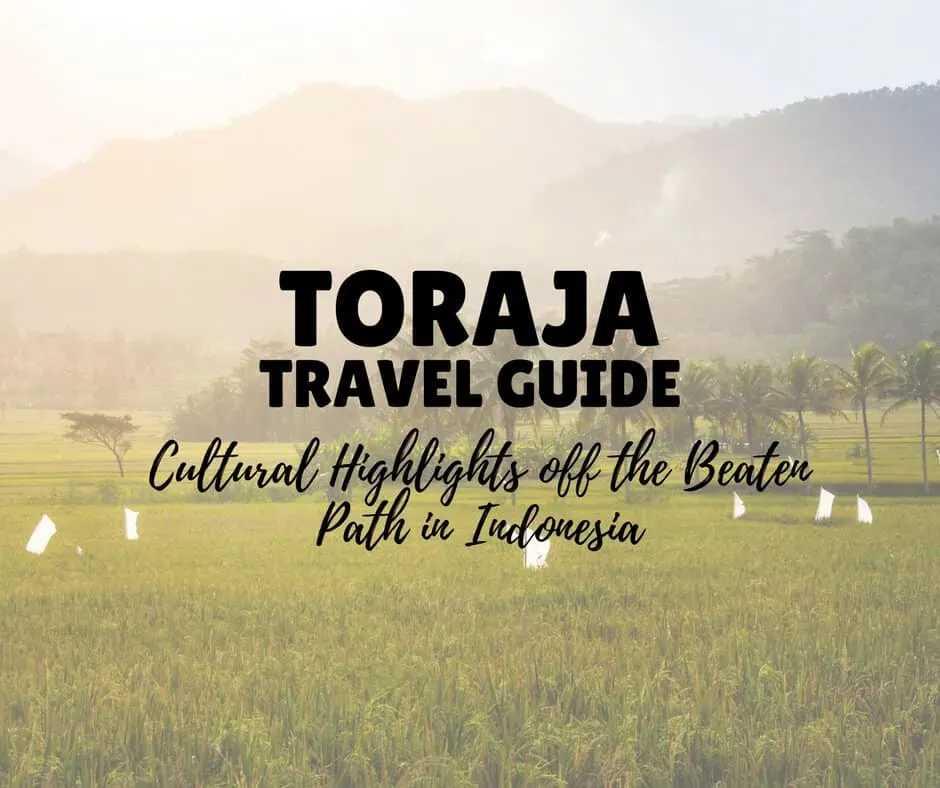
Exploring Toraja: Cultural Highlights Off the Beaten Path in Indonesia’s Highlands
Disclaimer: I visited the Tana Toraja Regency as a guest of Wonderful Indonesia as part of their #tripofwonders tour (hosted by the Indonesian Government) – and it was epic!
.
Who are the Torajans?
Up until the 20th century, the Torajans had little awareness of themselves as a distinct ethnic group. Living in the highlands of South Sulawesi Indonesia, surrounded by mountains, cut off from the outside world and aware of only others like them, they identified themselves as simply members of their village and it was only the arrival of Dutch Missionaries in 1920 and the formal establishment of the Tana Toraja regency in 1957 that sparked a sense of ethnic consciousness and the push for cultural survival.
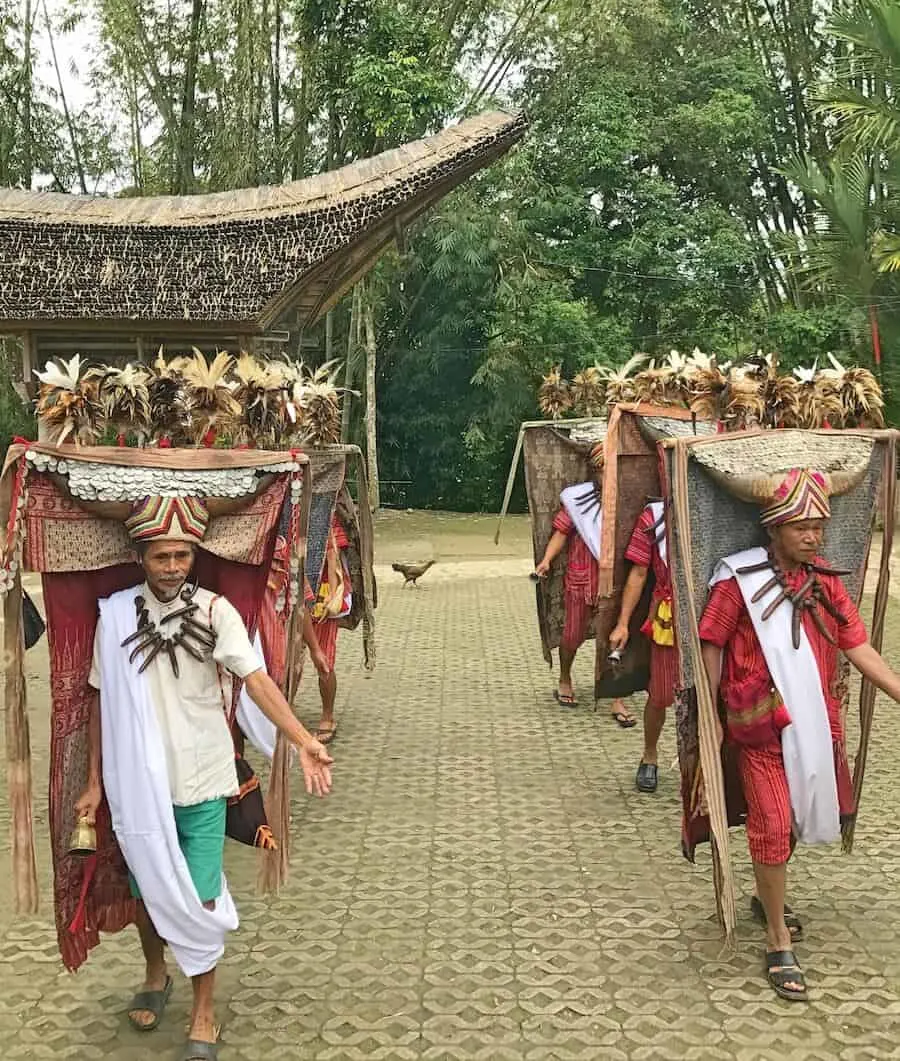
Torajan Men Performing the Manganda Dance as a sign of happiness
.
Toraja Societal Structure
Each village traditionally operated autonomously, and within each village, Torajan lived with three main types of affiliations: family, class and religion.
- Family: Family is the primary social function in Toraja, which each village considered as one extended family. Kinship between the family is reciprocal with every member of the village assisting with farming, buffalo rituals and even debts. Each child born in the village belongs to both the mothers and fathers families and represent the only bilateral family line in Indonesia.
- Class: In traditional Torajan society, family ties dictated your social class and were inherited from the mothers side of the family. There were three levels of class: nobles, commoners and slaves (although slavery was abolished in 1909) and it was taboo for a woman to marry ‘down’ – although marrying ‘up’ was a way to improve one’s social status.
- Religion: Toraja’s indigenous belief system is called Aluk to dolo / Aluk Todolo (the way of the ancestors, or sometimes simply, the way.) Despite the majority of Torajans now identifying as Christian, they have continued to follow the beliefs of the Aluk in as such that the that the world is made up of three sections: the upper world (heaven), the world of man (earth), and the underworld. They believe that their ancestors came down from heaven via stairs, which were then used to as a medium to communicate with the creator. Aluk to dolo is not just a belief system, but a combination of law, religion and values which govern social life, agricultural practices and ancestral rituals.
.
Torajan History in 2 mins
17th Century: Dutch claimed control in South Sulawesi through the Dutch East India Company
1920: Missionary work began in Toraja
1930: Muslim lowlanders attacked the Toraja resulting in a widespread conversion to Christianity and allegiance to the Dutch for protection
1946: Dutch grant Tana Toraja a regenschap
1957: Tana Toraja formally recognised as a regency of Indonesia
1965: Presidential decree stated that all Indonesians must identify themselves as one of the 5 official religions: Christianity (Protestant or Catholic) Buddhism, Islam or Hinduism
1969: The Torajan Religious Belief (Aluk or “the way of the ancestors”) was recognized as a branch/sect of Hinduism in Indonesia.
1972: Funeral ritual of Puang of Sangalla, the highest-ranking nobleman in Tana Toraja and the so-called “last pure-blooded Toraja noble. The event became somehwat of a tourist attraction and was witnessed by 400 visitors and recorded by National Geographic
.
Tana Toraja Funeral and Burial Practices – A Quick Summary
One of the most fascinating aspects of Torajan Culture are the complex funeral ceremonies, known as Rambu Solo, that is practiced by the Toraja people. The Torajans believe the most important thing about one’s life is their death and as such their life rituals are practically all in preparation for the corresponding burial rituals.
When a Torajan person dies, the Toraja people do not believe that death is immediate, but rather the deceased is a ‘sick person’. As the deceased can only be buried at certain times of the year (funeral season) and once a certain number of buffalo have been amassed for sacrifice (the number changes dependent on your status in society), the body remains in the family homes until this time. Loved ones continue to visit, talk to, and bring food to the dead persons and the body is preserved with formalin.
The body of the deceased may remain in the family home for weeks months or even years before the traditional death ceremonies of Rambu Solo can be enacted. As part of the burial ritual a traditional dance is performed, buffalo and pigs are sacrificed followed by a death feast (burial feast) on the sacrificed animals which is shared with the village; and in some cases a ceremonial cock fight is required. The sacrifice of animals is due to the Torajan belief that blood needs to be spilled on the ground to facilitate the transition of a soul to Puya (the land of the souls).
The deceased body is then finally interred into the carved out cave burial site of the families ancestors. The coffins are either places into hollowed out portions of the rock, or hung from rope on the outside of the cave, and life sized effigies (known as Tau Tau) are places in viewing boxes to watch over the entrance to the burial site. Each year following burial, the family perform ‘Ma’nene’ (The Ceremonial Cleaning of Corpses) where to deceased body is cleaned and redressed. (more on that below!). It is arguably one of the oldest traditional religions in the world and is fascinating to see in action!
READ MORE: Toraja Death Rituals: Cave Burials, Effigies & the Walking Dead!
.
Toraja’s Cultural Highlights
Londa

The Torajan’s cave burial system is one of the most complex in the world (as discussed above). Each village has it’s own cave grave site, a few of which can be visited, but Londa is unique in that is has two burial sites within the one cave.
The Torajan people believe that the sky represents the father, and the earth, the mother – and so in symbolically preserving the purity of the mother, the dead are not buried in the ground.
Instead they are interred in a natural or man-carved cave, with coffins placed into spaces in the rock, or hung off the side of the cliff. Some cave systems are large enough to fit generations of families, and each are watched over by the Tau Tau. These are life-sized effigies of the deceased made out of soft wood and dressed in the deceased clothes.
.
Ke’te Kesu
https://www.instagram.com/p/BXWo9HfFtSR/?taken-by=maketimetoseetheworld
A stunning example of a traditional Torajan village, the striking houses and graneries, known as Tongkonan, make for a picture perfect backdrop to this UNESCO World Heritage Site. The village has 6 Tongkonan, 12 Granaries (rice barns), a large open ceremonial ground and nearby cave burial site. Surrounded by rice paddies which continue to be farmed today, and with a museum located inside one of the Tongkonan displaying traditional wood carvings and artifacts you can begin to imagine what life was like there.
The Tongkonan features a boat shaped roof, the height of which is higher at the back in a symbol of a desire for prosperity for those residing in the house. The exterior is adorned with buffalo horns on a vertical pole at the front of the house, with the buffalo jaw bones strung up along the side as a symbol of the occupants wealth and status. The more Buffalo horns and jaws, the higher the prestige of the family.
The village of Ke’te Kesu’ is recognised in the Torajan highlands as a place where traditional customs are preserved in the ancestral houses. Torajan ceremonies are also held at the site from June through to December. For an additional fee you can pay for Torajan’s to perform a traditional dance such as the Manganda – which was danced to express their gratitude after war.
.
Kalimbuang Bori & The Megalith Stones
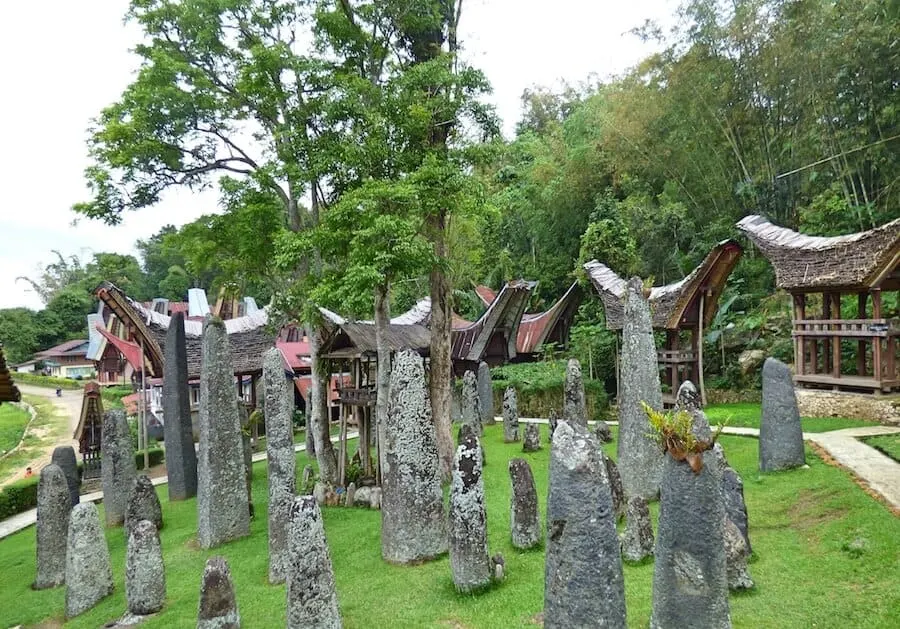
Located in Sesean Village, North Toraja, is an a traditional cave burial site carved into the cliff-side, at the base of which is a collection of Menhir/Megalith stones. Boasting over 102 stone structures, each of varying height, they are the traditional equivalent of a headstone to commemorate the life of a passed noble (although in line with cultural beliefs, no bodies are buried beneath the stones, but rather in the cave behind and above the site). The height of each is representative of how mnay water buffalo were sacrificed as part of the funeral rites and as such is an indication of the wealth and status of the deceased. Surrounding the collection of stones are several raised platforms built in the Tongkonan style where the bodies were displayed prior to their internment.
.
Batutumonga
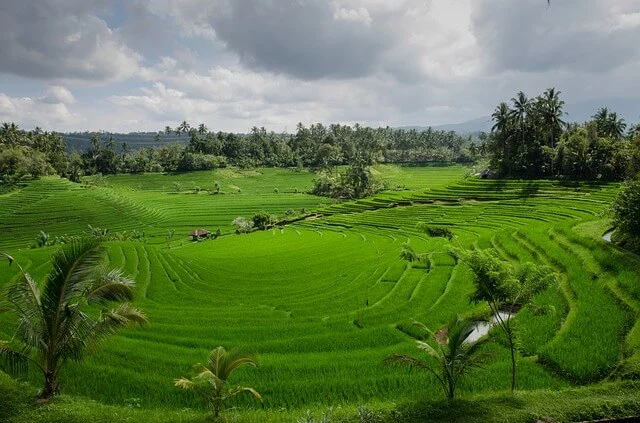
Located north of Rantepao, Batutumonga has garnered the name ‘land above the cloud’ because from that height, you can see the sea of cloud covering the neighboring hills and the cascading greenery. It is also the perfect spot to catch sunrise or sunsets.
.
The Sesean Mountain
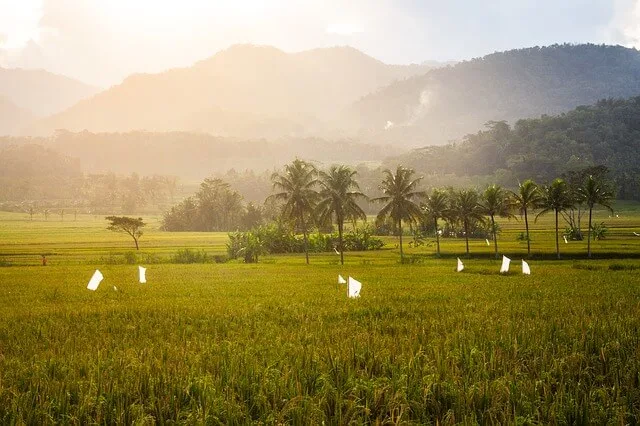
Although not the highest peak in the Southern Sulawesi area, it is sufficient to satisfy most hikers and is a popular trekking route. Your reward for getting out into nature is the fresh mountain air and incredible views of the surrounding hills and rice paddy fields. The track is accessible via a trail from Batutumonga and a return trip to the summit takes approximately five hours.
.
Pasar Bolu (Bolu Market)
The local market in the land of Toraja is where the majority of money changes hands in the region. Every 6 days, traders will arrive with cattle, buffalo and pigs which will be rigorously inspected by the Toraja people. Any perceived defect with the animals will affect it’s price – and with albino buffalo being sold for billions of rupiah, the stakes are high. Head on down to the market for a truly unique experience when you visit Toraja.
.
Sakonbong Village
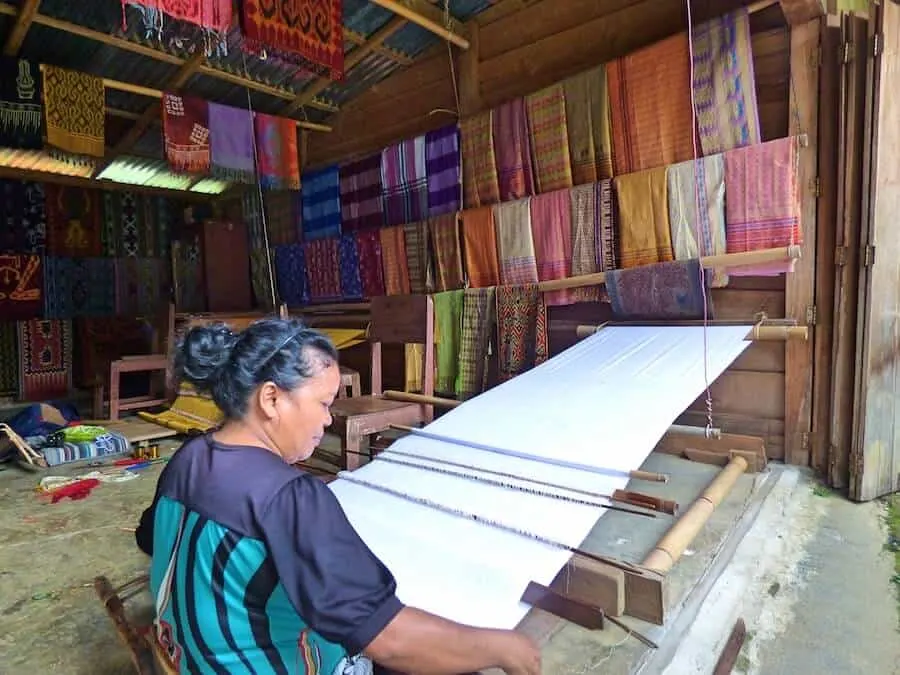
Visit another traditional Torajan village where you can watch how traditional linens and cloth are hand woven – and even give it a try yourself if you are brave enough! (I didn’t, as I didn’t want to ruin it!) Each design can take up to two weeks to weave by hand and the intricate designs are a work of art. The skills on display here have been passed down through the centuries, with fabrics dyed using local plants. This is the perfect place to buy some traditional fabric, which makes for the perfect scarf or piece of artwork – and one that you can almost guarantee no-one else will have in the world.
.
Toraja Arabica Coffee
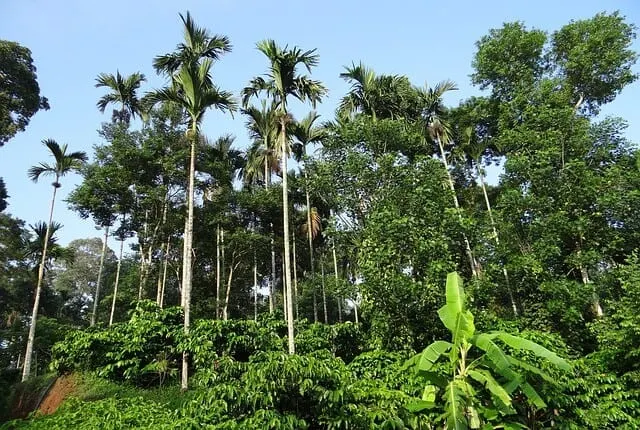
The Highlands of Toraja are renowned for producing some of the best coffee in the world. The high altitude, 3 month dry season and constant temperature between 16-20oC throughout the year make for ideal conditions for growing the beans. Due to it’s popularity, the majority of the coffee produced in Toraja is shipped internationally, however you can get your authentic Torajan coffee fix at Aras Café and a couple of other spots in the centre of town.
If coffee is totally your thing and just one cup is not going to cut it, you can also visit a plantation where the beans are grown and learn about the processing practices, before purchasing a stash to take home with you! (But maybe check your own countries import laws when it comes to food products before you buy!)
RELATED: If you’re a bit of a foodie, Bali has some of the best restaurants in the country! Click to read all about the Best Restaurants in Seminyak to get your tastebuds tingling!
.
Essential Visitor Info
How To Get to Toraja
You will likely arrive in Indonesia at either Bali or Jakarta International airports. From either of these you will be required to take a short domestic flight to Makassar in South Sulawesi, from which you then have two options:
- Internal flight to Palopo (approx 40 mins) followed by a 2.5 hour rive to Tana Toraja. Search flights here.
- 7-8 Hour Bus from Makassar to Torajaland. Some buses have air conditioning but not all have toilets. Buy your tickets here.
Where To Stay in Toraja
Toraja Heritage Hotel (4*)
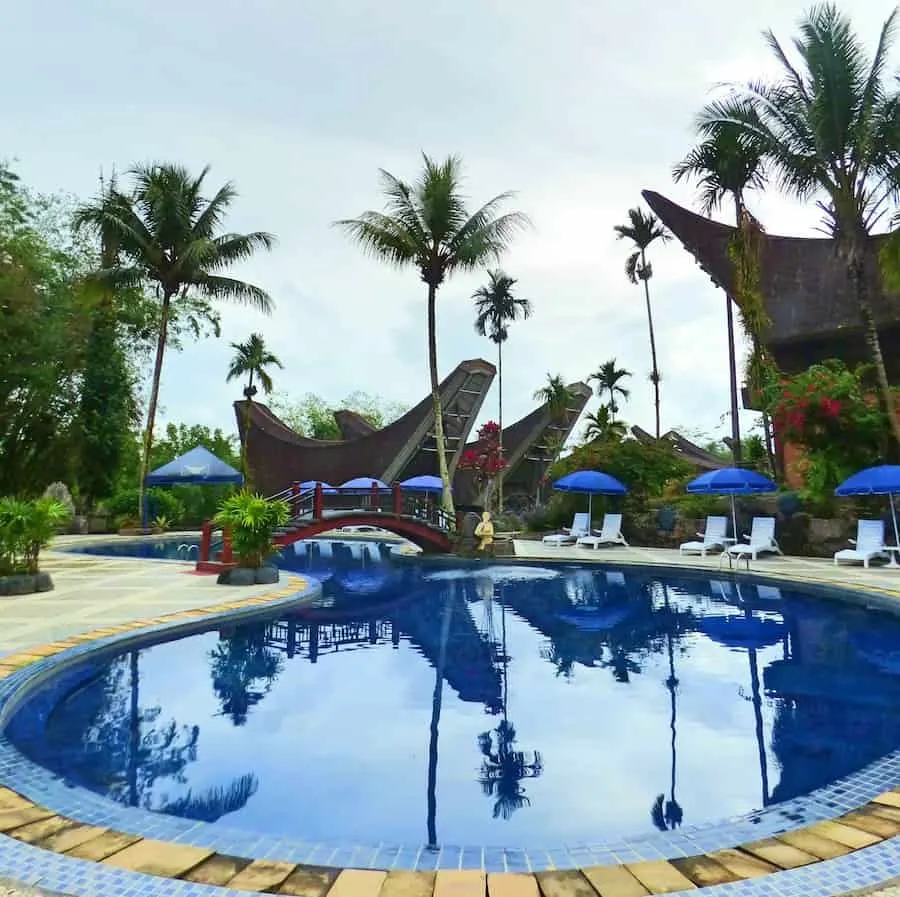
This beautiful hotels sits 700m above sea level with sweeping views of the surrounding hills. The rooms have been built in the style of a traditional Tongkonan and are tastefully decorated inside.
The hotel has an outdoor pool, spa, an onsite restaurant & bar and offers free wifi throughout the property. Reception are also able to help you arrange a driver to show you around the region, or even as far as Makassar if you don’t fancy taking the bus!
Book Now | Compare Prices for Later | Read Trip Advisor Reviews
Or If you have specific accommodation requirements, check out other Hotels in Tana Toraja to narrow down your search.
And that’s a wrap folks! I hope this travel guide has piqued your interest in Toraja and that it will be one of your stops on your next visit to Indonesia. Stay tuned for more on my ‘Beyond Bali’ series. There’s plenty more to come!
And if you liked this post, please tweet, pin & share!
Hi There! Thanks for reading my post about Exploring Tana Toraja: Cultural Highlights and Things To Do in Indonesia’s Highlands! I just wanted to let you know that this post contains affiliate links, which means if you purchase something after clicking a link, I may get a small commission – which is at absolutely no cost to you. If you enjoyed this article and are going to be searching for some of the things I mention anyway, I would love it if you could click through from the links above & thank you in advance! Read my full Disclosure here.
And Thank you for reading the MakeTimeToSeeTheWorld travel blog.

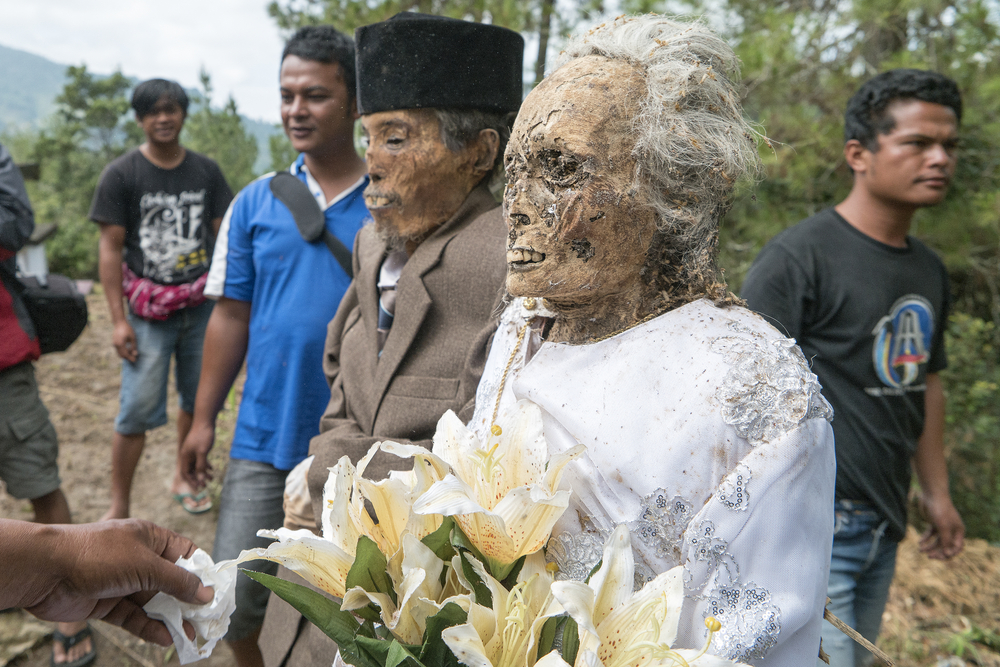
Maude
Friday 11th of January 2019
Loved your article! I'm going there in a month and I'm excited to discover that part of the world. Great explanations!
Vicki Garside
Friday 11th of January 2019
Thanks Maude! I hope you have a wonderful time!
Kate Storm
Tuesday 15th of August 2017
It never fails to amaze me how many different cultures and ethnic groups there are in the world. This is a great write up! It's wonderful to get a peek into such a different culture.
Vicki
Tuesday 15th of August 2017
Thank you! I totally agree it's fascinating! It's crazy to think the rest of the world only discovered these people 100 years ago!
David Meldrum
Sunday 13th of August 2017
I love history and love seeing and learning about different cultures! I find it interesting how they do death ceremonies. The photos are amazing!
James
Sunday 13th of August 2017
In Indonesia you are guaranteed to see things you've never seen before (outside Bali). Batutumonga is so green and lush, I would love to be there for either sunrise or sunset. I am planning to visit this part of Indonesia and would take the bus option to visit Toraja from Makassar (thanks for the link). The Toraja heritage hotel looks like the perfect place to stay, I love traditional hotels.
Katie
Sunday 13th of August 2017
Wow what a truly spectacular place! love all those amazing pictures of yours, I now definitely want to visit! Thanks for sharing!